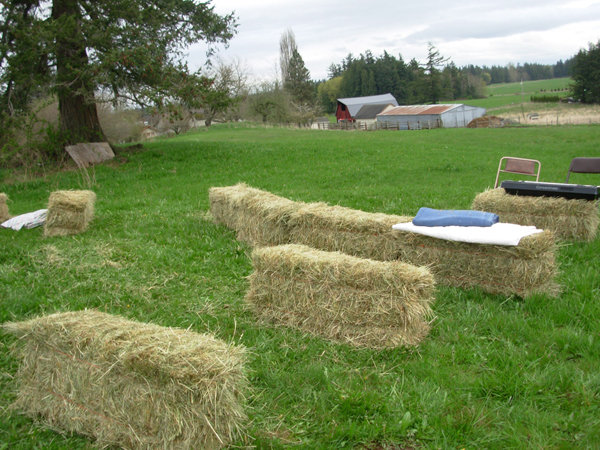
I’m still groggy every morning when I step out my front door onto the porch to make my way down a gravel driveway to get the newspaper. More often than not, it is still quite dark out at 5:15 AM. More often than not, my slippered foot lands on something a little crunchy and a little squishy and a lot icky on the welcome mat in front of my door.
The front porch cat, (as opposed to the back porch cat, the garden shed cat, the hay barn cat, the horse barn cat and the 3 stray cats) predator that she is, leaves behind certain remnants of her prey’s….uh, body parts. Mousey body parts or birdie body parts. I assume, from the consistency of the little carnivore compost pile, these are unappealing to the kitty, so become the “leavings”, so to speak, of the kill. Typically, it is a little mouse head, complete with little beady eyes, or a little bird head, complete with little beak, and something that looks suspiciously green and bulbous, like a gall bladder. I don’t think heads or gall bladders are on my preferred delicacy list either. And they are certainly not on my list of things I like to wear on the bottom of my slipper. Yet I do and I have.
I’m perplexed by this habit cats have of leaving behind the stuff they don’t want on the welcome mat, even the occasional whole shrew or field mouse, seemingly untouched by claw or incisor, but yet dead as a doornail on the doormat. Some cat owners naively think their cats are presenting them with “gifts” –kind of a sacrificial offering to the human god that feeds them. Nonsense. This is the universal trash heap for cats and a testimony to their utter disdain for humans. Leave for the human the unappetizing and truly grotesque…
So humanity is not alone of earth’s creatures to create garbage heaps of unwanted stuff. Not only cats, but barn owls are incredibly efficient at tossing back what they don’t want out of their furry meals. Our old hay barn is literally peppered with pellets, popular with high school biology classes for dissection instruction. These dried up brown fuzzy poop shaped objects are regurgitated by the owl after sitting in one of its two stomachs for a number of hours. Bird barf. It’s fairly interesting stuff, which is why these pellets (which we recycle by donating by the dozens to local schools) are great teaching material. It is possible to practically reconstruct a mouse or bird skeleton from a pellet, or perhaps even both on a night when the hunting was good. There is fur and there are feathers. Whatever isn’t easily digestible doesn’t have much purpose to the owl, so up it comes again and becomes so much detritus on the floor and rafters of my barn. Owl litter. There should be a law.
Then there is the rather efficient Haflinger horse eating machine which leaves no calorie unabsorbed, which vacuums up anything remotely edible within reasonable reach, even if reasonable means contortions under a gate or fence with half of the body locked under the bottom rung, and the neck stretched 6 feet sideways to grab that one blade of grass still standing. The reason why Haflingers don’t eventually explode from their intake is that Haflinger poop rivals elephant poop pound for pound per day, so there must be a considerable amount ingested that is indigestible and passed on, so to speak–like part of a tail wrap, the branches from the dogwood tree, that halter that went missing… you know, like those black holes in outer space–that’s what a Haflinger represents on earth.
This is quite different from the recycled “cud” of the typical herbivore cow who regurgitates big green gobs of grass/hay/silage to chew it again in a state of utter (udder?) contentment and pleasure. If humans could figure out how to recycle a good meal for another good chew or two, the obesity rate would surely drop precipitously. So would attendance at most happy hours. But then, how many skinny cows have I seen? Probably as many as purple cows. I never hope to see one, but I’d rather see than be one.
In my daily walk through life, I have my share of things I dump unceremoniously that I don’t want, don’t need, can’t use, or abandon when I only want the palatable so the rest can rot. Today is Earth Day, and I feel properly shamed and guilty for my contribution to landfills,despite my avid recycling efforts for the past 30 years. Nonetheless, I am in good company with my fellow carnivores and omnivores who daily leave behind what they don’t want or need and clearly don’t give a rip about Earth Day.
I now need to figure out that cud thing. I can go green and just might save on the grocery bill.

 3 months ago, the dogwood in an ice storm…
3 months ago, the dogwood in an ice storm…












 Fingers of twilight shadow
Fingers of twilight shadow